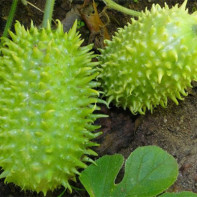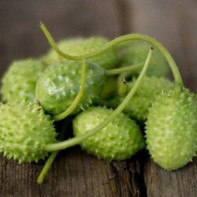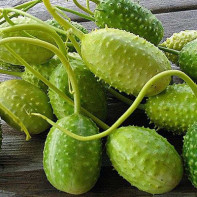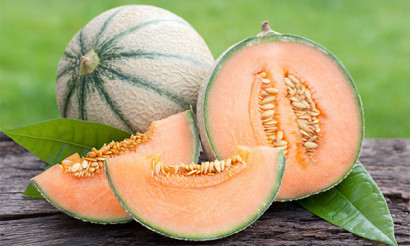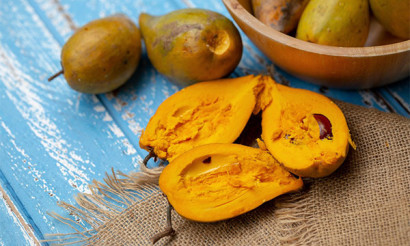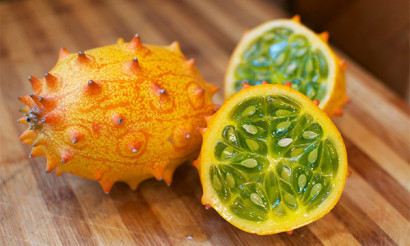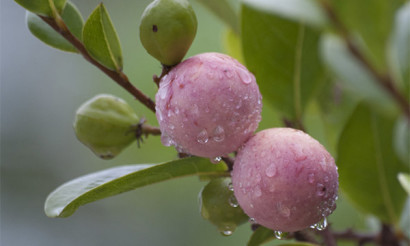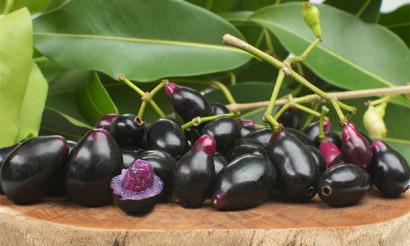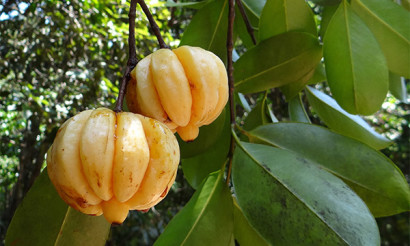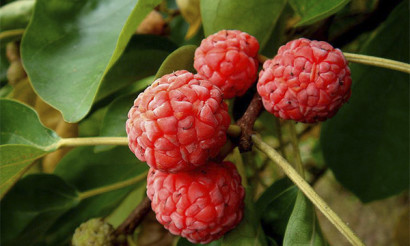Anguria: what kind of vegetable is it and how is it healthy
According to the traditions of domestic culinary, residents of post-Soviet countries regard exotic vegetables with a degree of distrust. For this reason, anguria or Antillean cucumber is not popular with us. Only gourmets who love overseas delicacies, and nutritionists include this unusual fruit in this group of products, willingly include it in their daily menu.
Fans of exoticism can be understood, because in reality the "prickly hedgehogs", as people aptly called this kind of cucumber for external features, have a pleasant taste and a lot of useful properties. In addition, the culture does not require special rules of care and perfectly survives in the southern regions of the Eurasian space. In a word, an unusual vegetable deserves attention and a worthy assessment of its delicious qualities. We will not lose time and get to know better the prickly garden culture.
What kind of vegetable
He is a representative of vegetable crops, belongs to the pumpkin family. True, an unusual vegetable in many ways confirms its kinship with an ordinary cucumber. Therefore, in many names assigned to it by the peoples of different countries, this similarity is emphasized. So, the culture is known under such names as horned and watermelon cucumber.
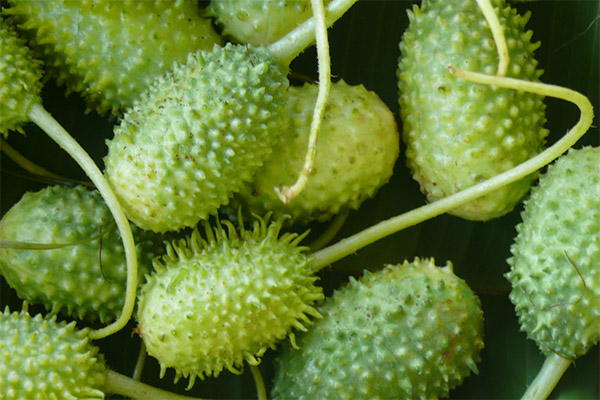
Vegetable is not rich in species diversity. On the Russian territory, mainly decorative varieties are grown, and this product is used very rarely in food. In European cuisine, Antillean cucumber is used to make original salads and appetizers. This unusual natural gift in America is especially popular.
What does it look like
Antilles cucumber belongs to the annual varieties of vegetable crops. The plant twists like a creeper, which resembles an ordinary cucumber. The main botanical characteristics of anguria:
- The horned cucumber forms a winding shrub reaching 5–6 m in height.
- Curly and carved leaves on the edges resemble foliage of gourds. They differ in that their entire surface is covered with small spikes.
- During flowering, the bush is covered with yellow fragrant flowers. Abundant flowering makes the plant attractive for use as a bright element of decor. Anguria is grown specifically to create hedges, and often the plant decorates even the facades of buildings. The flowering period lasts from early July to late autumn.
- Oblong shape, plump fruits are also completely covered with thorns, horns, hence one of the nicknames - hedgehogs. Antilles cucumber is very fertile. From one bush per season, you can collect up to hundreds of fruits, if the culture is well-maintained. On average, the weight of the fruit does not exceed 50 g.
- By the time of seed maturity, hedgehog cucumbers acquire a yellowish-orange color. In this form, they persist for a long time. Some enterprising craftsmen use them to create original crafts and souvenirs.
Reference: Anguria is a fast-ripening vegetable crop. The biological maturity of the fruit is observed only 70 days after emergence. But only greens of anguria are suitable for food, and overripe fruits look very beautiful against a hedge.
Where grows
A favorable habitat for anguria is the tropics and subtropics.Wild plants are more common. The most controversial opinions are expressed about the origin of this culture: some believe that it appeared on several continents at the same time, while others argue that the American Indians were engaged in the cultivation of an unusual vegetable. Later, the plant settled in different parts of the world, including the Russian Far East.
Today it is difficult to say whose side speaks of the true state of things, but the difference of opinion did not prevent the Antilles cucumber from getting a good job in Africa and Madagascar. Thanks to the efforts of breeders, varieties of a rare vegetable without bitterness were obtained, which are now grown in the southern United States and Latin America. There is a plant in Australia, but there is a negative attitude towards the American guest. Local farmers are relentlessly fighting weeds. It has become a serious problem for North American peanut fields. Russian gardeners are mainly engaged in the cultivation of decorative species.
It is interesting: often Antilles cucumber is confused with kiwano. Although these two cultures are close relatives, kiwano or horned melon grows up to 300-400 g, and the fruit tastes like a banana.
Species diversity
Gardeners with experience try to plant cultivars cultivated in other countries to decorate the design of their home gardens. The most popular of them:
- Gourmet. The creepers of this subspecies extend up to 3 m. The young fruits are covered with a soft pile, they are suitable for culinary purposes. Overripe florists willingly use to create original compositions.
- Syrian anguria is great for decorating relaxation areas. Large leaves and numerous shoots look great in open spaces, and sweet fruits are suitable for decorating dishes. This variety bears fruit until the frost.
- Dietary Anguria. This is the only variety that was listed back in 2013 in the Russian State Register of Cultivated Plants. Small fruits reach the ripening maturity approximately 50 days after germination. Juicy pulp is used for cooking diet foods. One bush per season produces approximately 50 fruits.
Helpful advice: when using anguria as a decorative element, the young shoot should be directed to the support, and when the plant launches its antennae, fresh greenery will envelop the arbor or climb by any artificial design.
What is useful anguria
Antilles cucumber in all respects is ideal for diet food. Ripe fruits are 88% water, and the following 12% are healthy substances:
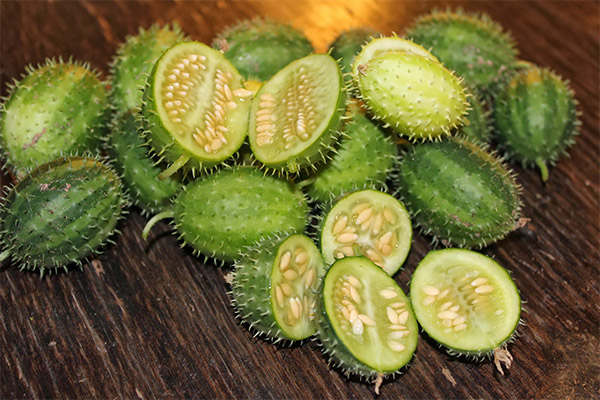
- Mineral elements. Exotic fruits contain a lot of iodine - an element necessary for the normal functioning of the thyroid gland. Magnesium and potassium support cardiac activity, and iron helps fight anemia. Selenium and zinc are involved in important biochemical processes, including they regulate the production of sex hormones.
- Vitamins In the fruits of anguria there is a complete set of B vitamins, a high content of ascorbic and nicotinic acid is noted. There are tocopherol and vitamin D.
In addition to these two important groups of substances, the vegetable product also has:
- cellulose;
- ashes;
- saccharides;
- organic acids;
- choline and some other components.
In addition to its rich composition, saturated with minerals and vitamins, American cucumber is notable for low calorie content. This indicator is only 44 kcal.
Nutrition value are only greenbacks. If they are regularly included in the diet as a useful component of diet food, such an additive will have the following positive effects on the body:
- normalizes the course of metabolic processes;
- will strengthen the immune resource;
- improves the functioning of the digestive system;
- cleanse the body of toxins and excess fluid;
- due to the high fiber content it will improve intestinal motility;
- strengthens the structure of the walls of blood vessels;
- prevent the development of thrombosis.
In principle, the Antillean cucumber is suitable for feeding people of any age. But especially the vegetable is popular with people with weight problems. It is enough to supplement the menu with this useful product, and the weight will gradually go away. As practice shows, without much effort and diets, you can lose 2-3 kg per week only at the expense of an exotic cucumber.
Note: the composition of an unusual cucumber has good anti-inflammatory activity. Especially this effect is fully manifested in the treatment of skin problems.
Which may be harmful
Antilles vegetable, like its counterpart, an ordinary cucumber, is considered one of the safest natural products. But since the body of each person has its own characteristics, there are a number of contraindications that should be considered if you want to include it in the basic complex of products. It is not recommended to eat a vegetable:
- children and adolescents;
- pregnant and lactating women;
- persons with individual intolerance to the product;
- patients with urolithiasis.
The ban applies to home medicines for internal use.
Important: even in the absence of contraindications, you should always consult a doctor. Anguria is an unusual product for our table, so this prudence will help to avoid undesirable consequences.
How to eat anguria
Young cucumbers, that is, greenery, are ideal for food variety and as a dietary supplement to everyday diet. Their juicy flesh saturated with sugars and vitamins has a pleasant taste. Supporters of natural nutrition eat fresh fruits, but they can be added to vegetable and fruit salads. Vegetable perfectly retains its nutritional properties in frozen form. Professional European culinary specialists love to use it as a decorative element to add aesthetics to ready-made dishes.
What can be cooked from anguria
For culinary purposes, only cultivated varieties of Antillean cucumber are suitable. With good care, one vine can remove up to 200 juicy fruits per season. Some lovers eat the whole fruit without peeling it.
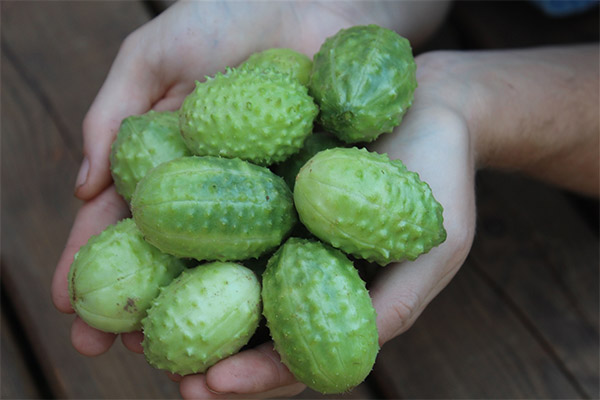
Unbelievably delicious, the pickled cucumbers are marinated. For this, any popular recipe that housewives like to use for pickling ordinary cucumbers is suitable.
Other fruit use options:
- If you cut the cucumber in half, you get two decorative cups that can be filled with whipped cream and pieces of biscuit.
- Thin fruit circles are great for decorating cups with a cocktail.
- Fruit desserts and ice cream can also be decorated with slices of sweet-sour vegetable.
Brazilians Zelentsy fry and stew. In principle, the Antillean cucumber meets all the culinary tasks that housewives solve using ordinary cucumbers.
It is interesting: in some countries, bitter varieties of wild anguria are used as a natural pesticide in granaries.
Application in traditional medicine
Of course, traditional healers could not disregard such a gift of nature as the Antilles cucumber. Its healing properties are actively used in eastern medicine, and recently, our herbalists began to use simple recipes. Some methods of treating common diseases with prickly cucumber are given for practical use.
- To expel the worms, ripe the seeds of the plant to dry, grind to pulp, and then dilute in half with water. Take 1-2 tbsp. once on an empty stomach.
- With bruises, you can quickly prepare an ointment that will relieve pain. To do this, extract fresh juice from young fruits, and then mix it with the same amount of olive oil. The resulting composition to rub sore spots. Store the finished ointment in the refrigerator.
- Ringworm Remedy. Pour fresh vinegar leaves with vinegar and leave for several days to insist. Then, with the finished composition, rub the problem areas several times a day.
- Sedative. 15 drops of fresh juice combine with honey and take before bedtime. Such a simple remedy will help get rid of insomnia and calm the nerves.
- With hemorrhoids, on the outside, to relieve pain, halves of the fresh fetus can be applied to the nodes. Such a compress acts almost instantly.
It is worth noting that the juice of Antillean cucumber has universal properties: it contributes to the healing of wounds and burns, it is taken orally with active tuberculosis.
Application in cosmetology
Another area of application for an unusual cucumber is home cosmetology. For normal daily care routines, you can use vegetable flesh or juice.
These components are useful to add to the composition of anti-aging masks.
- For example, you can make a simple composition of the pulp of anguria and banana. Apply the resulting mass to the face for a quarter of an hour, and then rinse with water. This procedure will refresh your face and remove wrinkles.
- If you wipe your face skin twice a day with a swab dipped in fresh juice of Antillean cucumber, you can get rid of freckles and age spots.
- Since the juice has anti-inflammatory properties, it can be used to solve the problem of acne.
How to grow anguria
The agricultural technology of Anguria is not distinguished by special rules. The only thing to consider if you want to decorate your estate, and at the same time to get a harvest of healthy fruits, is the thermophilic nature of this plant. Therefore, in our climatic conditions, in order to create favorable conditions for a culture, it is best to grow it in a greenhouse before emergence. Then you can plant seedlings in fertilized soil. Although the plant is not too whimsical, but there are a number of requirements that are worth fulfilling:
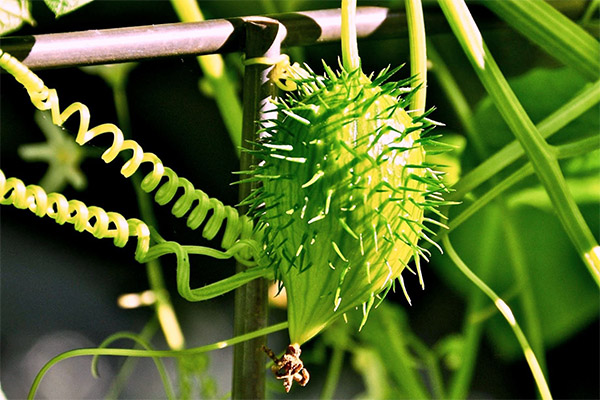
- The temperature regime is 21–28 ° C. The lower limit is + 8 ° C, the upper limit is + 32 ° C.
- The soil should be slightly alkaline, very moist.
- The plant requires constant watering.
- Anguria should be planted in places unprotected from the sun, protected from the wind.
- An ideal place for the Antillean cucumber is the hill where rainwater gets.
- Anguria grows well and bears fruit in places where legumes, cabbage or greens grew before it.
It remains to add that the culture is resistant to pests. Otherwise, it requires exactly the same care as cucumbers.
Interesting Fruit Facts
- According to some sources, the name of the culture is associated with the Antilles. From there, the birds carried seeds to other parts of the world.
- After the colonization of America, the plant was completely replaced from the continent, and it was replaced by an ordinary cucumber.
- In some countries, ripe red fruits are specially stored so that they can later decorate the Christmas tree.
«Important: all information on the site is provided exclusively in fact-finding purposes. Before applying any recommendations, consult with a profile specialist. Neither the editors nor the authors are liable for any possible harm caused materials. "


